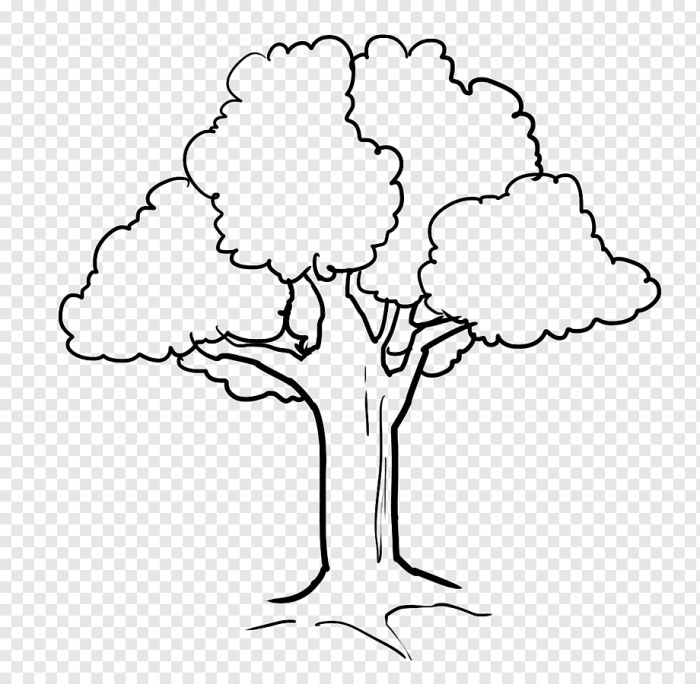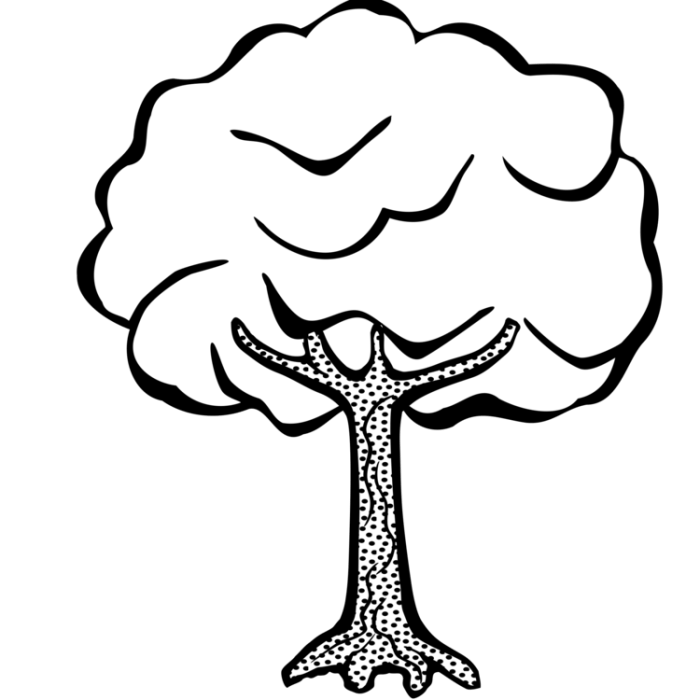Enhancing the Coloring Experience

Coloring book tree for kids – Let’s explore ways to make coloring this tree a more engaging and enriching activity for children of different ages. Adding interactive elements transforms a simple coloring page into a fun learning experience, boosting creativity and problem-solving skills.Adding interactive elements to the tree coloring page enhances the overall experience, transforming a simple coloring activity into a stimulating and educational one.
These elements cater to different developmental stages, making the activity enjoyable and beneficial for a wider age range.
Hidden Objects within the Tree
Hidden objects cleverly integrated into the tree’s design add a layer of discovery to the coloring activity. For example, small animals (squirrels, birds, owls) could be subtly hidden amongst the leaves and branches. These objects are not immediately apparent but require careful observation to find. They can be partially obscured by leaves or blended into the tree’s texture, adding a challenge.
The implementation involves carefully drawing these hidden objects within the tree’s foliage, ensuring they are detailed enough to be recognizable but still camouflaged. Their placement should be varied, encouraging thorough exploration of the entire page.
A Maze through the Tree Branches
A maze woven through the branches and leaves of the tree provides a spatial reasoning challenge. The maze’s path could wind through the tree’s canopy, around leaves, and under branches. The start and finish points could be clearly marked, perhaps as a bird’s nest and an acorn, respectively. The maze lines should be distinct but not so thick that they overwhelm the tree’s design.
The complexity of the maze can be adjusted to suit different age groups, with younger children having simpler mazes and older children facing more intricate challenges.
Kids love coloring trees! From majestic oaks to whimsical cartoon trees, a coloring book filled with trees offers hours of creative fun. If you’re looking for even more options, you can find a fantastic selection of designs at free printable coloring pages for kids , including many more tree designs to expand your little one’s artistic adventures.
Then, once you’ve printed some, you can add those to your own growing collection of tree coloring pages!
Connect-the-Dots to Create Tree Elements
Connect-the-dots is a classic activity that enhances fine motor skills and number recognition. For the tree, numbered dots could be placed to form additional elements, such as apples on the branches, flowers at the base of the tree, or even a friendly face in the tree trunk. This adds another dimension to the coloring page, turning it into a combined coloring and connect-the-dots activity.
The numbers should be clearly visible and spaced appropriately to avoid overcrowding the page. The complexity of the design created through connecting the dots should be adjusted based on the target age group.
Developmental Benefits of Interactive Elements, Coloring book tree for kids
| Interactive Element | Ages 3-5 | Ages 6-8 | Ages 9-11 |
|---|---|---|---|
| Hidden Objects | Develops observation skills and visual attention. | Enhances problem-solving skills and visual discrimination. | Improves focus and attention to detail; fosters patience. |
| Maze | Improves hand-eye coordination and spatial awareness. | Develops problem-solving and planning skills; enhances logical thinking. | Strengthens spatial reasoning and strategic thinking skills. |
| Connect-the-Dots | Develops fine motor skills and number recognition. | Enhances hand-eye coordination and sequencing skills. | Improves fine motor skills and spatial reasoning. |
Illustrative Details and Themes

This section explores three distinct thematic approaches for illustrating a tree in a children’s coloring book, each offering unique visual and creative opportunities. These themes provide diverse options for children to engage with their coloring experience, fostering imagination and creativity. Each theme includes specific illustrative elements and suggested color palettes to enhance the overall coloring experience.
Forest Scene
This theme depicts a tree as part of a larger forest ecosystem. The illustration should be bustling with life, showcasing the intricate details of a forest environment.The scene could include a variety of trees—tall pines, leafy deciduous trees, and perhaps even some smaller shrubs and bushes. A path winding through the forest could add depth and visual interest.
Animals could include squirrels scampering up tree trunks, birds perched on branches, a family of deer grazing in the undergrowth, and perhaps even a wise old owl nestled in a tree hollow. Sunlight filtering through the leaves would create dappled shadows on the forest floor, adding realism and texture.Appropriate color palettes could feature earthy greens and browns for the trees and undergrowth, punctuated by pops of vibrant color from wildflowers and animal fur.
A palette of muted greens, deep browns, and soft yellows could evoke a feeling of quiet serenity, while a brighter palette using emerald greens, burnt oranges, and sunny yellows could create a more energetic and lively atmosphere.
Tree Through the Seasons
This theme showcases the same tree throughout the year, highlighting the changes in its appearance across the four seasons.Spring could show the tree bursting with fresh, light green leaves and delicate blossoms. Summer could depict lush, full foliage, perhaps with birds nesting in its branches. Autumn could show the leaves changing color—reds, oranges, yellows, and browns—with fallen leaves scattered on the ground.
Winter could display a bare, snow-covered tree, its branches reaching towards a clear, winter sky. A small animal, such as a rabbit or a bird, could be included in each seasonal depiction to further highlight the changes in the environment.For spring, a palette of pastel greens, pinks, and yellows would create a soft, gentle mood. Summer could use vibrant greens, blues, and yellows for a sunny and cheerful feeling.
Autumn would benefit from warm reds, oranges, yellows, and browns, creating a cozy and comforting atmosphere. Winter could use a palette of cool blues, whites, and grays, conveying a sense of peace and quiet.
Tree with Animals
This theme centers on a tree as a habitat for various animals, showcasing a thriving ecosystem.The tree could be a large, sturdy oak or a tall, leafy willow, providing ample space for different animals to live and play. Animals could include a family of squirrels nesting in a hollow, birds building nests in the branches, a friendly raccoon peering out from behind the trunk, and butterflies flitting amongst the leaves.
The tree could be surrounded by flowers and plants, attracting more insects and animals.Color palettes could range from bright and playful, using vibrant colors for the animals and flowers, to more muted and naturalistic tones, focusing on the earthy colors of the tree and its surroundings. A palette of bright blues, greens, yellows, and oranges could evoke a feeling of joy and excitement, while a more subdued palette of greens, browns, and grays could create a sense of calm and tranquility.
Essential Questionnaire: Coloring Book Tree For Kids
What kind of paper is best for coloring book pages?
Thicker paper, such as cardstock, is ideal to prevent bleed-through from markers or crayons.
How can I make the coloring pages more durable?
Laminating the finished pages adds durability and allows for repeated use.
What are some alternative interactive elements beyond those mentioned?
Spot-the-difference activities, simple puzzles, or word searches related to trees and nature are other engaging options.
Are there any copyright concerns when creating and distributing a coloring book?
Ensure all artwork is original or uses royalty-free images to avoid copyright infringement.
